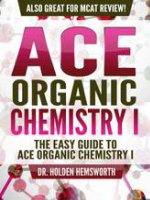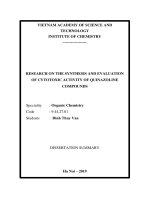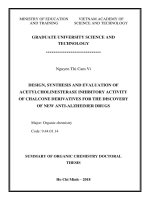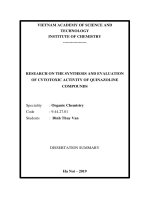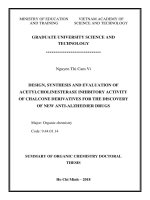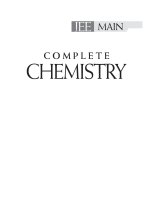Comprehensive organic chemistry for IIT JEE main and advanced
Bạn đang xem bản rút gọn của tài liệu. Xem và tải ngay bản đầy đủ của tài liệu tại đây (42.15 MB, 807 trang )
www.pdfgrip.com
Notion Press
Old No. 38, New No. 6
McNichols Road, Chetpet
Chennai – 600 031
First Published by Notion Press 2017
Copyright © Amitava Mazumder 2017
All Rights Reserved.
eISBN 978-1-948352-50-5
This book has been published with all reasonable efforts taken to make the
material error-free after the consent of the author. No part of this book shall
be used, reproduced in any manner whatsoever without written permission
from the author, except in the case of brief quotations embodied in critical
articles and reviews.
The Author of this book is solely responsible and liable for its content
including but not limited to the views, representations, descriptions,
statements, information, opinions and references [“Content”] . The Content
of this book shall not constitute or be construed or deemed to reflect the
opinion or expression of the Publisher or Editor. Neither the Publisher nor
Editor endorse or approve the Content of this book or guarantee the
reliability, accuracy or completeness of the Content published herein and do
not make any representations or warranties of any kind, express or implied,
including but not limited to the implied warranties of merchantability, fitness
for a particular purpose. The Publisher and Editor shall not be liable
whatsoever for any errors, omissions, whether such errors or omissions result
from negligence, accident, or any other cause or claims for loss or damages
of any kind, including without limitation, indirect or consequential loss or
damage arising out of use, inability to use, or about the reliability, accuracy
or sufficiency of the information contained in this book.
www.pdfgrip.com
Preface
Purpose and mission
This book is intended to become a useful companion for the Engineering Test
Aspirants of India in areas of accuracy, usability, relevance for the
examination, flexibility, and connection with their needs. This text would
evolve over the years and should eliminate much of the cost for owning
several costly top-quality college-level organic chemistry texts, by putting
together the relevant material in one book, and, we hope would contribute
eventually to the building of our nation by creating top quality minds.
Author
The author of this book, Amitava Mazumder, had finished his graduation in
Engineering from N.I.T. – Durgapur and his Post Graduation in Industrial
Metallurgy from Jadavpur University-Kolkata, and has more than ten years
experience of teaching Chemistry to the Engineering Entrance Test aspirants
in Delhi, Kota and Dubai. He presented his thesis for International
Conference for Manufacturing in Dhaka, Bangladesh in 2000 and published
his paper in the proceedings of the same conference.
Amitava intends that this book should keep on evolving by contributions
from all in the student and teaching community and therefore welcome
comments and suggestions so that he can better serve his dream of creating
well informed and thoroughly prepared engineering aspirants.
About this book
One of the main difficulties students have with organic chemistry is
organizing the information in their minds. An engineering entrance aspirant
very quickly will learn over hundreds of chemical reactions. Consequently, it
is vital that students take time to not only organize the information, but also
to understand it. Indeed, excellent organic chemistry professors will tell,
contrary to popular belief, one do not really need to memorize anything for
organic chemistry, instead, one simply needs to understand it. By truly
learning something, rather than memorizing it, the students will be able to
apply concepts beyond what they are memorizing. This book intends to help
www.pdfgrip.com
the students in getting into the core concepts of Organic Chemistry and
encourage them to always ask why something is the case. This book would
direct them to inquire, and find out the answer. By taking this approach the
student will enrich the learning experience, and the information will be
“locked” in their mind so that they are able to face the challenging problems
of entrance examinations.
Contributions
Amitava has always endeavored to research facts and interpretations
available in the best Organic Chemistry books, and, present it to the students
of India in a form that they would understand thoroughly. He has freely
learned from the writings of eminent authors in this field and for this book he
has drawn from this knowledge so that the students can get a comprehensive
source of organic chemistry for entrance examinations in this book. Amitava
therefore thanks all those authors, and would always be indebted to them for
enrichingAmitava’s knowledge of the very vast field of organic chemistry.
Specifically he is thankful to his parents who have always nurtured and
motivated him to follow his dream, his wife Swati & siblings Sudip, Swagata,
Sudeshna, nephew Rishi who have stood by him in the most difficult times. A
special thanks to Mr.R.K. Verma, founder director of Resonance Institute of
Kota, who has always motivated Amitava to selflessly contribute to the
welfare of the students. Amitava is also deeply indebted to Mr. Arijit Das,
who has motivated from the beginning itself and who has designed the front
and back cover of the book as well as the preface, Prof. U. C. Ghosh, Prof. K.
L. Ghatak (Presidency College, Kolkata), who were his teachers, Dr. R.C.
Sharma, Mr. Lokesh Khandelwal, Dr. Bikramjit Basu (IIT-Kanpur), Mr.R.K.
Bandopadhyaya, Dr.V. P. Mittal, Mr. Pramod Rana, Mr.Ramashish Paul for
always encouraging Amitava to author this book, and for guiding his vision
of serving the ambitions of the students of India.
Finally .. ...
In spite of our best efforts this first edition may contain several inadvertent
errors and misprints. I hope that you would sincerely pardon the author for
the same andAmitava looks forward to your sincere contributions to keep on
improving this effort.
After all a knowledgeable Indian student is a pride for all ofus.
www.pdfgrip.com
-Amitava Mazumder
May 2006
www.pdfgrip.com
Acknowledgement
My mom Mrs Kalyani Mazumder, dad Late Mr. Suprasanna Kumar
Mazumder, wife Swati. and kids Anuska and Aayush; Mr. Mahesh Patil
(IPS), Mrs. Archana Patil, Mr. Pratap Singh (Commisioner, IRS), my sibling
Sudip, Swagata, Dr. Sudeshna, Prof. Bikramjit Basu (Prof. IISc, Bangalore),
Isha Sethi, Mr. Sanjeev Sethi (cfo, Star TV), Prof. Asish Arora (Physics), Mr.
R.K. Verma ( MD, Resonance), Mr. Jitendra Panda (MD, Peerless, Kolkata).
Mrs. Sumi, Pratik, and Projwal; thanks to Ms. Gabriela Caster and Ms.
Preethi.K of Notion Press and their team as a whole.
www.pdfgrip.com
Contents
1) IUPAC Nomenclature
2) General Organic Chemistry
3) Isomerism
4) Nucleophilic substitution and elimination
5) Alkane
6) Alkenes
7) Alkynes
8) Alkyl halide, Grignard's reagent
9) Alcohol
10) Ether (cyclic, acyclic), thioether
11) Aromatic electrophilic substitution
12) Aromatic hydrocarbons
13) Aromatic halides
14) Phenol
15) Carbonyl compounds
16) Carboxylic acids
17) Carboxylic acid derivatives
18) Aliphatic and aromatic nitro compounds
19) Amines
20) Carbohydrate
21) Amino acid
22) Polymer
23) Practical organic chemistry
24) Reagent list
Exercises
www.pdfgrip.com
IUPAC Nomenclature
In the early days an organic compound was named as per their origin or
their characteristic property. These names are called as common name or
trivial name. Take an example like formic acid (HCOOH). It originates from
ant & the latin name of ant is formicium and also it behaves like an acid.
Thus the name formic acid is given. But with increasing number of organic
compounds & complexities name, scientific tools were developed by an
international body, famously called as International Union of Pure and
Applied Chemists in the year 1947. Since then this IUPAC system has been
followed to name the compound. We will observe while naming the organic
compounds that in some cases trivial names or common name’s have been
retained by IUPAC.
Paraffins or alkanes (general formula CnH 2n + 2) : First look that there
can be several types of C and H in the simplest alkane There are the
compounds made up single bond between C–atoms (due to its catenation
property)
1° C means that C, which is attached to only one C. Like wise 2°, 3°, 4°
and 1°, 2°, 3° H means that corresponding H-atoms are attached to 1° C, 2°
C, 3° C respectively. There cannot be any 4° H.
Let us introduce the functional groups & their names available in organic
chemistry in table-1.
Table-1 Names and formulae of functions and classification of acyclic
compounds with examples(G=general, I=IUPAC name)
www.pdfgrip.com
www.pdfgrip.com
Table-2
Some simple alkanes or paraffins
www.pdfgrip.com
Olefins or alkenes (General formula CnH2n) :
Table-3 Some simple alkenes or olefins
Alkynes (General Formula CnH2n-2) :
Some alkynes or acetylenes
Some simple alicyclic hydrocarbons
www.pdfgrip.com
Some common benzenoid aromatic hydrocarbons (Arenes)
IUPAC System of nomenclature
1. Unsaturated hydrocarbons
Case- Unbranched alkane : Count the number of C–atoms and write the
1
name depending on number of C–atoms as mentioned in table-2) i.e.
for 1–Carbon methane, for 2-carbons ethane etc.
www.pdfgrip.com
Case- Branched alkane : Count the C–atoms in the longest chain and
2
consider the other radicals as the substituents.
The longest chain contains 7-C atoms in the above.
Base name is heptane.
Now 3 methyl group are in branches so, they are called as substituents.
To name them follow the rule that (a) lowest locant rule, in which the
alkyl substituent should get minimum locant which ever comes first. So,
the name of the compound is 3, 4, 5-trimethylpentane.
Use hyphen and no gap between number & substituent. If there are two
different alkyl groups then the seniority will be according to the
alphabetical order and listing of name also will be according to the
alphabetical order.
So, the name is 3-ethyl 4-methylhexane.
There is another rule called as lowest sum rule popularly used for the
organic compounds having functional groups, also can be applied here.
So, lowest sum in the way shown at the top can give us the right
numbering. The rule tells us that the sum of the locants should be minimum
to write the correct name.
Case- Complex branching with compound substituent : In this case d of
3 : di, t of tri, c of cyclo, i of iso, n of neo has to be considered as the part
of alphabets but not the s of sec, t of tert (i.e. tertiary) etc. are
www.pdfgrip.com
considered while determining the alphabetical serniority. If a
compound possess two or more identical compound substituents then
we use bis, tris, tetrakis, pentakis instead of di, tri, tetra, penta etc.
respectively. Look at the following examples;
The name is 1, 3, 5 tris (isopropyl) cyclohexane. tris (name of the
radical) pattern has been followed with the specification of position. We
can also write 1, 3, 5 tris (1-methyl ethyl)cycloclohexane. For cyclic
molecules (also acyclic molecules) most substituted part is taken as the
base chain. If number of C–atoms is less outisde then the base name
used for cyclic compound.Forexamples ;
Like groups should get similar treatments, so base name is propane and
the name is 1, 3 dicyclo-butylpropane for the last figure.
Alkenes, Cyclo alkenes : Priority of double bond is given in a chain. With
the branching of alkyl groups, the priority goes to double bond. It has no
prefix and only shown as suffix (ene) used after the root name.
www.pdfgrip.com
For the other functional groups the name of the functional groups
(common, IUPAC), prefix, suffix in the priority order has been shown in the
following table. The priority order is followed upto
group. I
www.pdfgrip.com
www.pdfgrip.com
After
(amino) group the groups with only prefix are given preference
according to their seniority and according to the alphabetical order and listing
of the same is also according to the alphabetical order.
-CO2 H (carboxylic acid) :
1- Count the C of – CO2 H and put it in the longest chain (look this is a
terminal group).
2- Find the base name i.e. rest name and add ‘oic acid’ at last and follow
seniority. Take for example;
With cyclic compounds C of CO2 H is not counted in the main chain,
therefore use carboxylic acid.
- CHO (aldehyde) :
This is also a terminal group, rule 1 is followed as above. At the end we use
‘al’
For the cyclic compounds we use carboxaldehyde.
www.pdfgrip.com
For example;
It is a non terminal group. Count the C– in the main chain at minimum locant
in simple ketones. Otherwise follow the seniority table.
For example ;
The above names are retained. So derivatives of these compounds will get the
base names of the above compounds.
www.pdfgrip.com
www.pdfgrip.com
www.pdfgrip.com
N-Ethyl–N –methylpropanamine. Here we count number of carbon atoms
along the chain having maximum C as the root name (i. e. alkanamine part
comes from the alkane with longest chain)
www.pdfgrip.com
Aromatic amines have common names and are used as their base names
while writing the names of their derivtives.
IUPAC has retained the common names for aromatic amine like aniline etc.
The other groups Cl, Br, I, NO2 etc. are used as prefix and seniority depends
on alphabetical seniority of their names. Examples ;
Likewise , considering the smaller alkyl group in the alkoxy part and larger
alkyl group as alkane, the name of the following compound is ;
If we understand the naming then we can derive structural formula of the
www.pdfgrip.com
organic compounds.
Some common as well as IUPAC names of benzene derivatives
www.pdfgrip.com
General Organic Chemistry
Introduction :
Before going into the chemistry of organic compounds, we will briefly
understand the concept of orbitals in a very brief manner and then
gradually go into the depth. For this we need to have knowledge in
physical chemistry where atomic structure is taught.
Concept of orbital :
The mathematical form of the movement of electrons round the nucleus
considering wave particle duality of electron was given by Schrodinger,
which was
Where, y = wave function, (x, y, z) are the variable coordinate positions
of the electron, m= mass of the electron, h= Planck’s constant, E, V are
total energy and potential energy of the electron respectively.
Solving for radial wave functions, we obtain,
where Z = no. of protons, a0 = first Bohr’s radius, r = radial distance of
the electron from the nucleus. Therefore radial probability will be R2
and characteristic graphs are ,
www.pdfgrip.com
